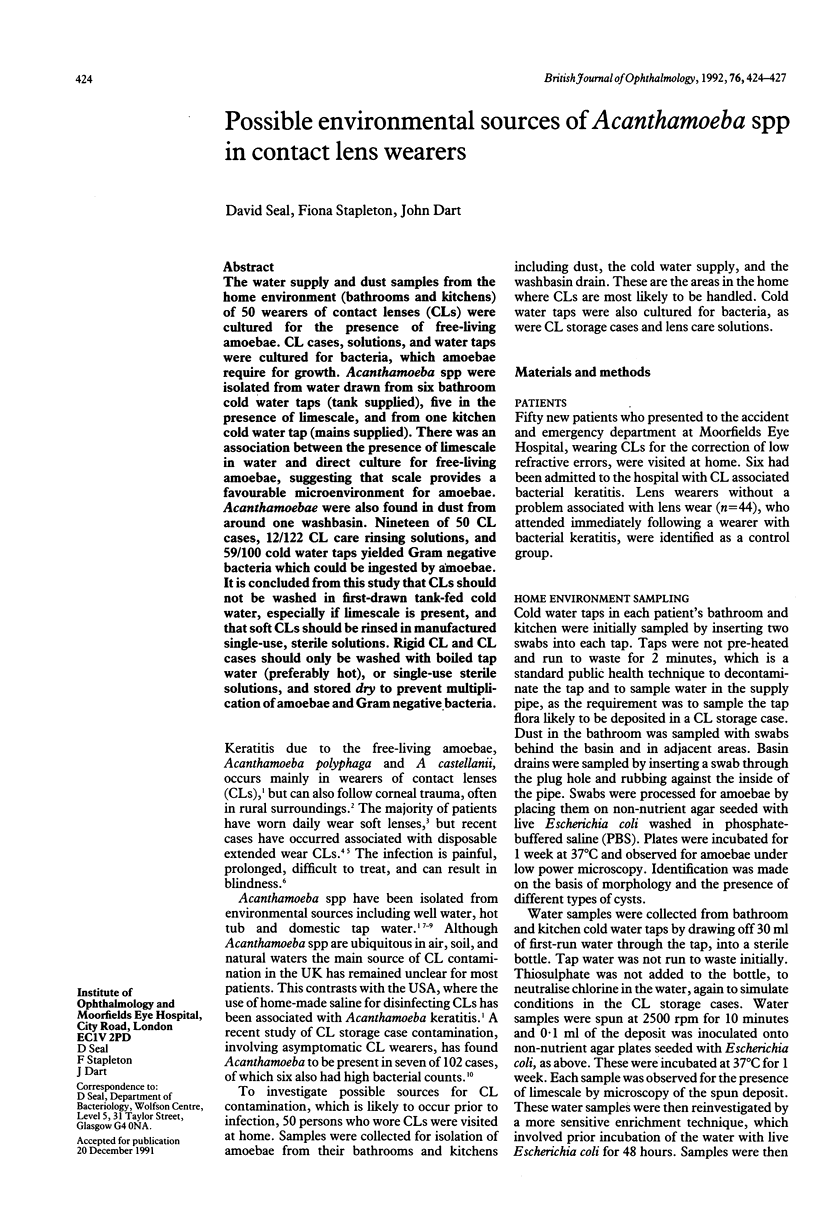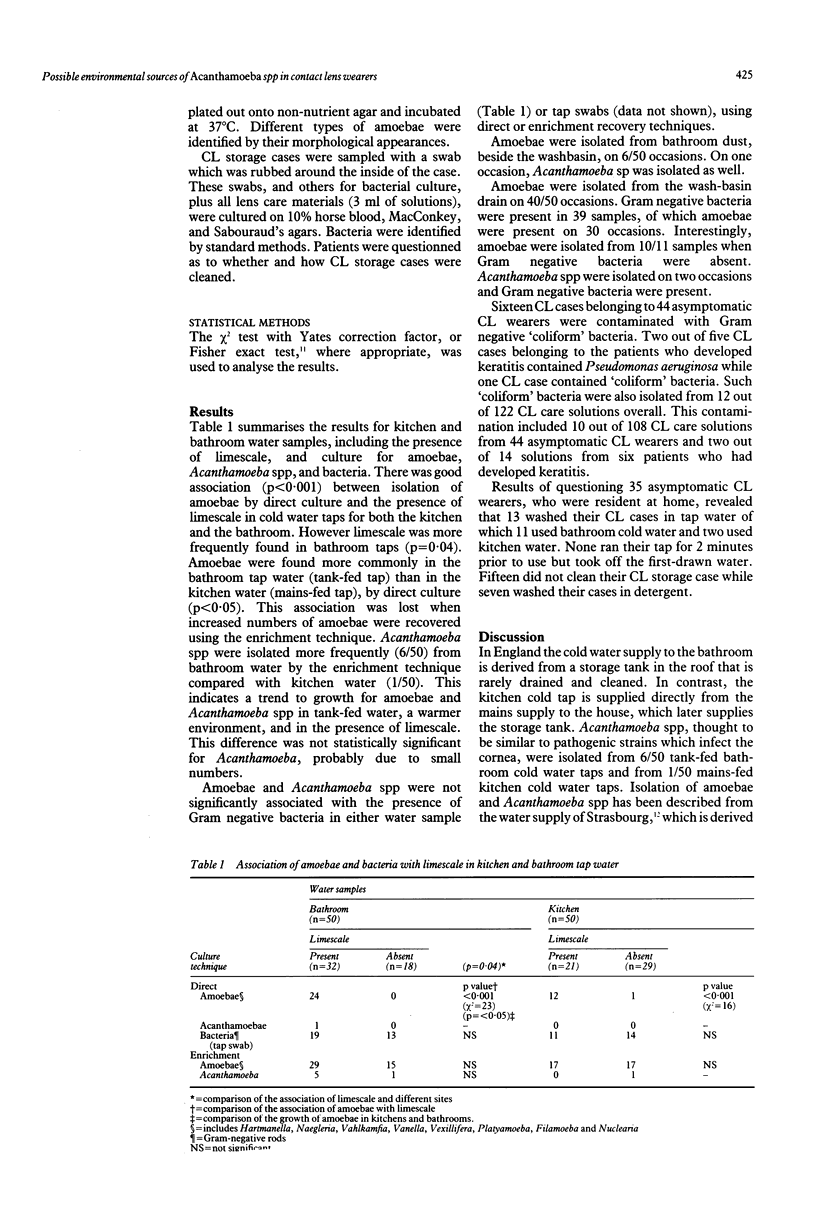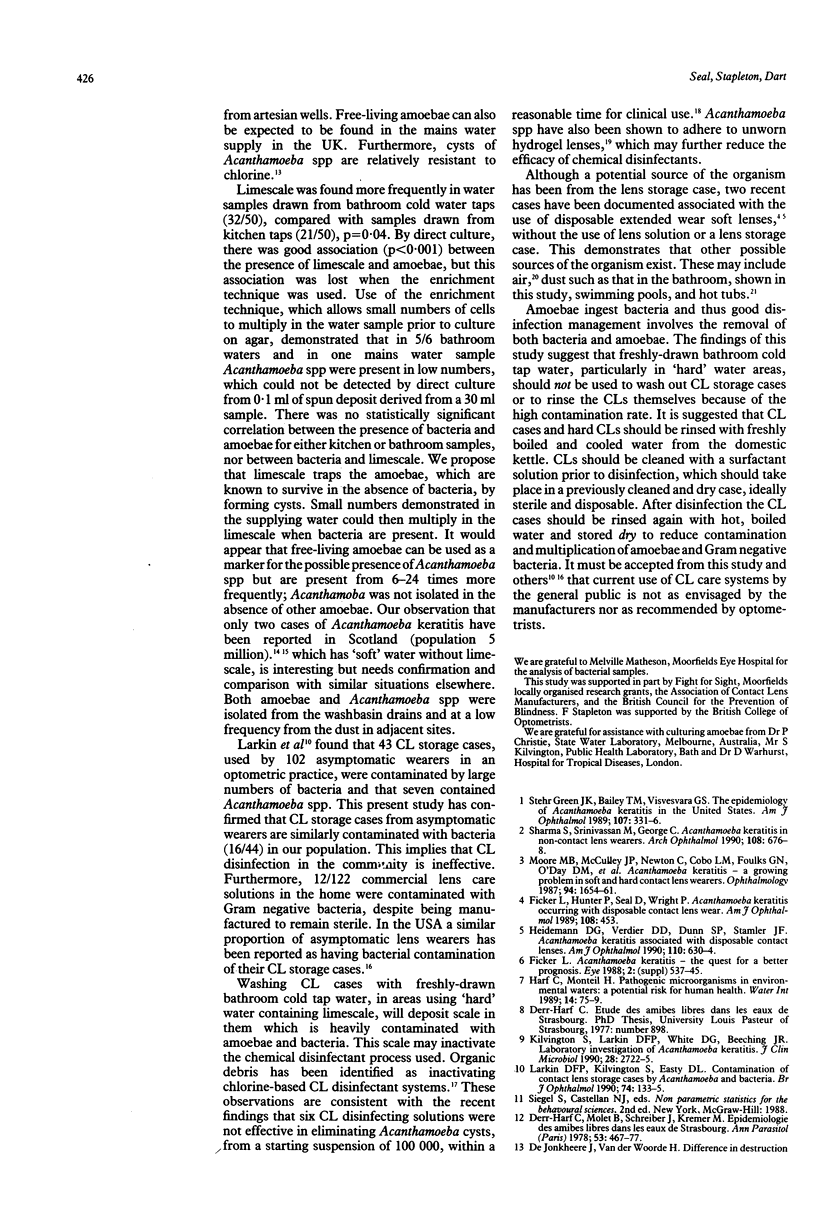Abstract
The water supply and dust samples from the home environment (bathrooms and kitchens) of 50 wearers of contact lenses (CLs) were cultured for the presence of free-living amoebae. CL cases, solutions, and water taps were cultured for bacteria, which amoebae require for growth. Acanthamoeba spp were isolated from water drawn from six bathroom cold water taps (tank supplied), five in the presence of limescale, and from one kitchen cold water tap (mains supplied). There was an association between the presence of limescale in water and direct culture for free-living amoebae, suggesting that scale provides a favourable microenvironment for amoebae. Acanthamoebae were also found in dust from around one washbasin. Nineteen of 50 CL cases, 12/122 CL care rinsing solutions, and 59/100 cold water taps yielded Gram negative bacteria which could be ingested by amoebae. It is concluded from this study that CLs should not be washed in first-drawn tank-fed cold water, especially if limescale is present, and that soft CLs should be rinsed in manufactured single-use, sterile solutions. Rigid CL and CL cases should only be washed with boiled tap water (preferably hot), or single-use sterile solutions, and stored dry to prevent multiplication of amoebae and Gram negative bacteria.
Full text
PDF



Selected References
These references are in PubMed. This may not be the complete list of references from this article.
- Brandt F. H., Ware D. A., Visvesvara G. S. Viability of Acanthamoeba cysts in ophthalmic solutions. Appl Environ Microbiol. 1989 May;55(5):1144–1146. doi: 10.1128/aem.55.5.1144-1146.1989. [DOI] [PMC free article] [PubMed] [Google Scholar]
- Derr-Harf C., Molet B., Schreiber J., Kremer M. Epidémiologie des amibes libres dans les eaux de Strasbourg. Ann Parasitol Hum Comp. 1978 Sep-Oct;53(5):467–477. [PubMed] [Google Scholar]
- Donzis P. B., Mondino B. J., Weissman B. A., Bruckner D. A. Microbial contamination of contact lens care systems. Am J Ophthalmol. 1987 Oct 15;104(4):325–333. doi: 10.1016/0002-9394(87)90219-4. [DOI] [PubMed] [Google Scholar]
- Ficker L., Hunter P., Seal D., Wright P. Acanthamoeba keratitis occurring with disposable contact lens wear. Am J Ophthalmol. 1989 Oct 15;108(4):453–453. doi: 10.1016/s0002-9394(14)73319-7. [DOI] [PubMed] [Google Scholar]
- Heidemann D. G., Verdier D. D., Dunn S. P., Stamler J. F. Acanthamoeba keratitis associated with disposable contact lenses. Am J Ophthalmol. 1990 Dec 15;110(6):630–634. doi: 10.1016/s0002-9394(14)77059-x. [DOI] [PubMed] [Google Scholar]
- John T., Desai D., Sahm D. Adherence of Acanthamoeba castellanii cysts and trophozoites to unworn soft contact lenses. Am J Ophthalmol. 1989 Dec 15;108(6):658–664. doi: 10.1016/0002-9394(89)90857-x. [DOI] [PubMed] [Google Scholar]
- Kilvington S., Larkin D. F., White D. G., Beeching J. R. Laboratory investigation of Acanthamoeba keratitis. J Clin Microbiol. 1990 Dec;28(12):2722–2725. doi: 10.1128/jcm.28.12.2722-2725.1990. [DOI] [PMC free article] [PubMed] [Google Scholar]
- Kingston D., Warhurst D. C. Isolation of amoebae from the air. J Med Microbiol. 1969 Feb;2(1):27–36. doi: 10.1099/00222615-2-1-27. [DOI] [PubMed] [Google Scholar]
- Larkin D. F., Kilvington S., Easty D. L. Contamination of contact lens storage cases by Acanthamoeba and bacteria. Br J Ophthalmol. 1990 Mar;74(3):133–135. doi: 10.1136/bjo.74.3.133. [DOI] [PMC free article] [PubMed] [Google Scholar]
- Moore M. B., McCulley J. P., Newton C., Cobo L. M., Foulks G. N., O'Day D. M., Johns K. J., Driebe W. T., Wilson L. A., Epstein R. J. Acanthamoeba keratitis. A growing problem in soft and hard contact lens wearers. Ophthalmology. 1987 Dec;94(12):1654–1661. [PubMed] [Google Scholar]
- Samples J. R., Binder P. S., Luibel F. J., Font R. L., Visvesvara G. S., Peter C. R. Acanthamoeba keratitis possibly acquired from a hot tub. Arch Ophthalmol. 1984 May;102(5):707–710. doi: 10.1001/archopht.1984.01040030563018. [DOI] [PubMed] [Google Scholar]
- Sharma S., Srinivasan M., George C. Acanthamoeba keratitis in non-contact lens wearers. Arch Ophthalmol. 1990 May;108(5):676–678. doi: 10.1001/archopht.1990.01070070062035. [DOI] [PubMed] [Google Scholar]
- Stehr-Green J. K., Bailey T. M., Visvesvara G. S. The epidemiology of Acanthamoeba keratitis in the United States. Am J Ophthalmol. 1989 Apr 15;107(4):331–336. doi: 10.1016/0002-9394(89)90654-5. [DOI] [PubMed] [Google Scholar]


